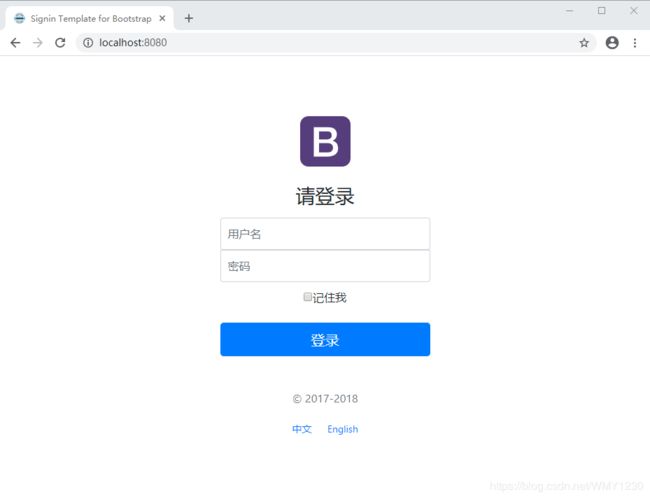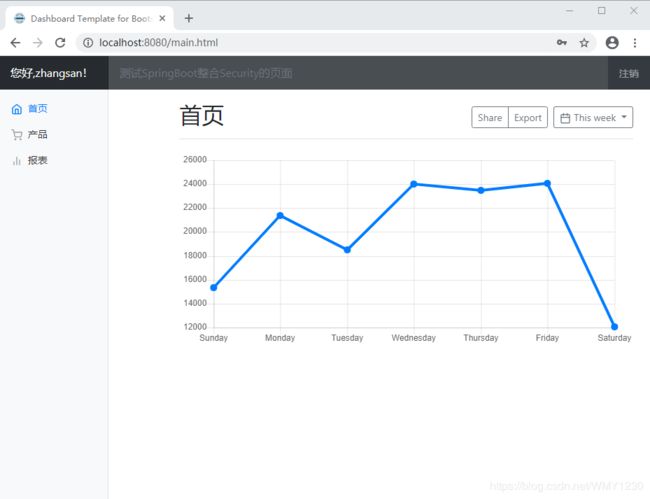SpringBoot(十八)——————SpringBoot整合Security、SpringSecurity原理
Security参考文档:https://spring.io/guides/gs/securing-web/
thymeleaf参考文档:https://www.thymeleaf.org/doc/articles/springsecurity.html
thymeleaf集成security源码:https://github.com/thymeleaf/thymeleaf-extras-springsecurity
官网文档:https://docs.spring.io/spring-security/site/docs/5.2.2.RELEASE/reference/htmlsingle/#community
源码地址:https://github.com/877148107/springboot_integrate/tree/master/springboot-integrat-security
目录
简介
SpringBoot整合Security
1)、效果图
2)、引入thymeleaf、security的pom文件
3)、编写security的配置类
1.定制请求授权的规则
2.开启自动配置的登录模式
4.开启自动配置的注销模式
5.定制认证规则
4)、security页面控制
1.获取登录名
2.角色权限
3.更多标签的使用
5)、页面跳转
Spring Security运行原理
1)、初始化认证配置规则
2)、初始化请求授权规则
3)、登录验证原理
整合过程中出现的错误信息
1)、密码认证
-
简介
Spring Security是一个功能强大且高度可定制的身份验证和访问控制框架。它是用于保护基于Spring的应用程序的实际标准。
Spring Security是一个框架,致力于为Java应用程序提供身份验证和授权。与所有Spring项目一样,Spring Security的真正强大之处在于可以轻松扩展以满足自定义要求
Spring Security是针对Spring项目的安全框架,也是Spring Boot底层安全模块默认的技术选型。他可以实现强大的web安全控制。对于安全控制,我们仅需引入spring-boot-starter-security模块,进行少量的配置,即可实现强大的安全管理。
特征
-
对身份验证和授权的全面且可扩展的支持
-
防止攻击,例如会话固定,点击劫持,跨站点请求伪造等
-
Servlet API集成
-
与Spring Web MVC的可选集成
-
与thymeleaf的可选集成
核心类
-
WebSecurityConfigurerAdapter:自定义Security策略
-
AuthenticationManagerBuilder:自定义认证策略
-
@EnableWebSecurity:开启WebSecurity模式
-
SpringBoot整合Security
1)、效果图
2)、引入thymeleaf、security的pom文件
使用bootstrap的demo作为基础模板页面,详细整合thymeleaf说明:https://blog.csdn.net/WMY1230/article/details/103724042
4.0.0
org.springframework.boot
spring-boot-starter-parent
2.2.4.RELEASE
com.wmy.integrate
springboot-integrat-security
0.0.1-SNAPSHOT
springboot-integrat-security
Demo project for Spring Boot
1.8
org.thymeleaf.extras
thymeleaf-extras-springsecurity5
org.springframework.boot
spring-boot-starter-security
org.springframework.boot
spring-boot-starter-thymeleaf
org.webjars
jquery
3.3.1
org.webjars
bootstrap
4.0.0
org.springframework.boot
spring-boot-starter-web
org.springframework.boot
spring-boot-starter-test
test
org.junit.vintage
junit-vintage-engine
org.springframework.security
spring-security-test
test
org.springframework.boot
spring-boot-maven-plugin
3)、编写security的配置类
1.定制请求授权的规则
控制没有请求路径的权限功能,达到只有这个角色的权限才能访问
http.authorizeRequests()......2.开启自动配置的登录模式
定制登录表单参数、登录请求、登录成功后跳转的请求、登录失败后跳转的请求
http.formLogin()......4.开启自动配置的注销模式
可以自己定制注销的请求路径默认是/logout,并且默认请求方式是post。当你使用超链接作为注销按钮发送请求时默认使用的get,因此需要自己指定请求的方式
http.logout()......5.定制认证规则
认证规则可以从内存里面获取也可以从数据库进行获取验证,这里先使用内存进行认证。后面更新使用数据库的security认证方式。。。。。
auth.inMemoryAuthentication()......
auth.jdbcAuthentication()......@EnableWebSecurity
public class MySecurityConfig extends WebSecurityConfigurerAdapter {
/**
* 定制请求授权规则
* @param http
* @throws Exception
*/
@Override
protected void configure(HttpSecurity http) throws Exception {
//所有角色都能访问
http.authorizeRequests().antMatchers("/").permitAll()
//订单管理员的访问权限
.antMatchers("/page/order/**","/page/report/**","/page/customer/**").hasRole("orderManager")
//产品管理员的访问权限
.antMatchers("/page/product/**","/page/report/**").hasRole("productManager")
//系统管理员的访问权限
.antMatchers("/page/**").hasRole("systemManager")
//登录才能访问
.antMatchers("/main.html").authenticated();
//开启自动配置的登录模式
http.formLogin()
//定制表单的名称
.usernameParameter("userName").passwordParameter("password")
//the URL "/login", redirecting to "/login?error" for authentication failure.
//这里配置默认是SpringSecurity的登录页面,需要配置成自己的登录页面
.loginPage("/")
//定制URL处理器登录请求
.loginProcessingUrl("/user/login")
//登录成功后跳转的页面
.successForwardUrl("/page/main")
//登录失败后跳转的页面
.failureForwardUrl("/");
//开启自动配置的注销功能,注销请求路径/logout并注销session
http.logout()
//由于页面采用的是超链接get请求方式进行注销,而自动配置默认使用的post请求
.logoutRequestMatcher(new AntPathRequestMatcher("/logout","GET"))
//配置注销成功跳转的url
.logoutSuccessUrl("/");
//开启自动配置的记住我,这里form表单的name默认是remember-me,也可以自己定义参数名
http.rememberMe();
}
/**
* 定制认证规则
* @param auth
* @throws Exception
*/
@Override
protected void configure(AuthenticationManagerBuilder auth) throws Exception {
//在内存里面校验
auth.inMemoryAuthentication()
//这里需要对密码进行编码不然会抛异常,详细情况可以参考错误信息及官方文档
.passwordEncoder(new BCryptPasswordEncoder())
//分别赋予登录的角色编码
.withUser("admin").password(new BCryptPasswordEncoder().encode("123456")).roles("systemManager","productManager","orderManager")
.and()
.withUser("zhangsan").password(new BCryptPasswordEncoder().encode("123456")).roles("productManager")
.and()
.withUser("lisi").password(new BCryptPasswordEncoder().encode("123456")).roles("orderManager");
}
}4)、security页面控制
引入thymeleaf集成security的名称空间
xmlns:sec="http://www.thymeleaf.org/extras/spring-security"1.获取登录名
可以使用thymeleaf集成security的标签SPEL表达式获取
您好,!2.角色权限
判断当前登录人的角色是否有访问权限
订单
3.更多标签的使用
thymeleaf参考文档:https://www.thymeleaf.org/doc/articles/springsecurity.html
thymeleaf集成security源码:https://github.com/thymeleaf/thymeleaf-extras-springsecurity
Title
5)、页面跳转
@RequestMapping("/page")
@Controller
public class PageController {
/**
* 跳转到主页面
* @return
*/
@RequestMapping("/main")
public String mianPage(){
return "redirect:/main.html";
}
/**
* 跳转到订单页面
* @return
*/
@RequestMapping("/order")
public String orderPage(){
return "/page/order/order";
}
/**
* 跳转到产品页面
* @return
*/
@RequestMapping("/product")
public String productPage(){
return "/page/product/product";
}
/**
* 跳转到顾客页面
* @return
*/
@RequestMapping("/customer")
public String customerPage(){
return "/page/customer/customer";
}
/**
* 跳转到报表页面
* @return
*/
@RequestMapping("report")
public String reportPage(){
return "/page/report/report";
}
/**
* 跳转到系统页面
* @return
*/
@RequestMapping("/system")
public String systemPage(){
return "/page/system";
}
}
-
Spring Security运行原理
1)、初始化认证配置规则
这里对配置的用户名、密码及角色配置初始化加载进入内存中。利用User里面的内部类UserBuilder对象进行保存。这里的角色并且都默认加了ROLE_前缀
public void init(final WebSecurity web) throws Exception {
final HttpSecurity http = getHttp();
web.addSecurityFilterChainBuilder(http).postBuildAction(() -> {
FilterSecurityInterceptor securityInterceptor = http
.getSharedObject(FilterSecurityInterceptor.class);
web.securityInterceptor(securityInterceptor);
});
} protected final HttpSecurity getHttp() throws Exception {
if (http != null) {
return http;
}
DefaultAuthenticationEventPublisher eventPublisher = objectPostProcessor
.postProcess(new DefaultAuthenticationEventPublisher());
localConfigureAuthenticationBldr.authenticationEventPublisher(eventPublisher);
//初始化认证规则,并加入到内存中
AuthenticationManager authenticationManager = authenticationManager();
authenticationBuilder.parentAuthenticationManager(authenticationManager);
authenticationBuilder.authenticationEventPublisher(eventPublisher);
Map, Object> sharedObjects = createSharedObjects();
http = new HttpSecurity(objectPostProcessor, authenticationBuilder,
sharedObjects);
if (!disableDefaults) {
// @formatter:off
http
.csrf().and()
.addFilter(new WebAsyncManagerIntegrationFilter())
.exceptionHandling().and()
.headers().and()
.sessionManagement().and()
.securityContext().and()
.requestCache().and()
.anonymous().and()
.servletApi().and()
.apply(new DefaultLoginPageConfigurer<>()).and()
.logout();
// @formatter:on
ClassLoader classLoader = this.context.getClassLoader();
List defaultHttpConfigurers =
SpringFactoriesLoader.loadFactories(AbstractHttpConfigurer.class, classLoader);
for (AbstractHttpConfigurer configurer : defaultHttpConfigurers) {
http.apply(configurer);
}
}
configure(http);
return http;
}
protected AuthenticationManager authenticationManager() throws Exception {
if (!authenticationManagerInitialized) {
configure(localConfigureAuthenticationBldr);
if (disableLocalConfigureAuthenticationBldr) {
authenticationManager = authenticationConfiguration
.getAuthenticationManager();
}
else {
authenticationManager = localConfigureAuthenticationBldr.build();
}
authenticationManagerInitialized = true;
}
return authenticationManager;
} protected void configure(AuthenticationManagerBuilder auth) throws Exception {
//在内存里面校验
auth.inMemoryAuthentication()
//这里需要对密码进行编码不然会抛异常,详细情况可以参考错误信息及官方文档
.passwordEncoder(new BCryptPasswordEncoder())
//分别赋予登录的角色编码
.withUser("admin").password(new BCryptPasswordEncoder().encode("123456")).roles("systemManager","productManager","orderManager")
.and()
.withUser("zhangsan").password(new BCryptPasswordEncoder().encode("123456")).roles("productManager")
.and()
.withUser("lisi").password(new BCryptPasswordEncoder().encode("123456")).roles("orderManager");
}2)、初始化请求授权规则
这里初始化请求权限、登录、注销等规则信息,并且启动相关的配置比如可以配置上启动防止跨域请求的配置等等。。。。
protected final HttpSecurity getHttp() throws Exception {
if (http != null) {
return http;
}
DefaultAuthenticationEventPublisher eventPublisher = objectPostProcessor
.postProcess(new DefaultAuthenticationEventPublisher());
localConfigureAuthenticationBldr.authenticationEventPublisher(eventPublisher);
//初始化认证规则,并加入到内存中
AuthenticationManager authenticationManager = authenticationManager();
authenticationBuilder.parentAuthenticationManager(authenticationManager);
authenticationBuilder.authenticationEventPublisher(eventPublisher);
Map, Object> sharedObjects = createSharedObjects();
http = new HttpSecurity(objectPostProcessor, authenticationBuilder,
sharedObjects);
if (!disableDefaults) {
// @formatter:off
http
.csrf().and()
.addFilter(new WebAsyncManagerIntegrationFilter())
.exceptionHandling().and()
.headers().and()
.sessionManagement().and()
.securityContext().and()
.requestCache().and()
.anonymous().and()
.servletApi().and()
.apply(new DefaultLoginPageConfigurer<>()).and()
.logout();
// @formatter:on
ClassLoader classLoader = this.context.getClassLoader();
List defaultHttpConfigurers =
SpringFactoriesLoader.loadFactories(AbstractHttpConfigurer.class, classLoader);
for (AbstractHttpConfigurer configurer : defaultHttpConfigurers) {
http.apply(configurer);
}
}
//初始化请求授权规则、登录、注销、记住我。。。。。
configure(http);
return http;
} 加载到内存中的多个配置类
{Class@5308} "class org.springframework.security.config.annotation.web.configurers.CsrfConfigurer" -> {ArrayList@5483} size = 1
{Class@5315} "class org.springframework.security.config.annotation.web.configurers.ExceptionHandlingConfigurer" -> {ArrayList@5484} size = 1
{Class@5316} "class org.springframework.security.config.annotation.web.configurers.HeadersConfigurer" -> {ArrayList@5485} size = 1
{Class@5336} "class org.springframework.security.config.annotation.web.configurers.SessionManagementConfigurer" -> {ArrayList@5486} size = 1
{Class@5341} "class org.springframework.security.config.annotation.web.configurers.SecurityContextConfigurer" -> {ArrayList@5487} size = 1
{Class@5342} "class org.springframework.security.config.annotation.web.configurers.RequestCacheConfigurer" -> {ArrayList@5488} size = 1
{Class@5343} "class org.springframework.security.config.annotation.web.configurers.AnonymousConfigurer" -> {ArrayList@5489} size = 1
{Class@5345} "class org.springframework.security.config.annotation.web.configurers.ServletApiConfigurer" -> {ArrayList@5490} size = 1
{Class@5347} "class org.springframework.security.config.annotation.web.configurers.DefaultLoginPageConfigurer" -> {ArrayList@5491} size = 1
{Class@5357} "class org.springframework.security.config.annotation.web.configurers.LogoutConfigurer" -> {ArrayList@5492} size = 1
{Class@5367} "class org.springframework.security.config.annotation.web.configurers.ExpressionUrlAuthorizationConfigurer" -> {ArrayList@5493} size = 1
{Class@5381} "class org.springframework.security.config.annotation.web.configurers.FormLoginConfigurer" -> {ArrayList@5494} size = 1
{Class@5416} "class org.springframework.security.config.annotation.web.configurers.RememberMeConfigurer" -> {ArrayList@5495} size = 13)、登录验证原理
使用FilterChainProxy代理执行多个过滤器filter,拦截登录请求、注销等等。登录用到了UsernamePasswordAuthenticationFilter用户名密码验证的过滤器
@Override
public void doFilter(ServletRequest request, ServletResponse response)
throws IOException, ServletException {
if (currentPosition == size) {
if (logger.isDebugEnabled()) {
logger.debug(UrlUtils.buildRequestUrl(firewalledRequest)
+ " reached end of additional filter chain; proceeding with original chain");
}
// Deactivate path stripping as we exit the security filter chain
this.firewalledRequest.reset();
originalChain.doFilter(request, response);
}
else {
currentPosition++;
Filter nextFilter = additionalFilters.get(currentPosition - 1);
if (logger.isDebugEnabled()) {
logger.debug(UrlUtils.buildRequestUrl(firewalledRequest)
+ " at position " + currentPosition + " of " + size
+ " in additional filter chain; firing Filter: '"
+ nextFilter.getClass().getSimpleName() + "'");
}
nextFilter.doFilter(request, response, this);
}
}
}0 = {WebAsyncManagerIntegrationFilter@5443}
1 = {SecurityContextPersistenceFilter@6879}
2 = {HeaderWriterFilter@6878}
3 = {CsrfFilter@6875}
4 = {LogoutFilter@6873}
5 = {UsernamePasswordAuthenticationFilter@5517}
6 = {RequestCacheAwareFilter@7008}
7 = {SecurityContextHolderAwareRequestFilter@7007}
8 = {RememberMeAuthenticationFilter@7006}
9 = {AnonymousAuthenticationFilter@7141}
10 = {SessionManagementFilter@7142}
11 = {ExceptionTranslationFilter@7143}
12 = {FilterSecurityInterceptor@7144} UsernamePasswordAuthenticationFilter,对用户名密码的验证,并获取登录人的角色,验证通过后添加记住我的cookie和session
public void doFilter(ServletRequest req, ServletResponse res, FilterChain chain)
throws IOException, ServletException {
HttpServletRequest request = (HttpServletRequest) req;
HttpServletResponse response = (HttpServletResponse) res;
if (!requiresAuthentication(request, response)) {
chain.doFilter(request, response);
return;
}
if (logger.isDebugEnabled()) {
logger.debug("Request is to process authentication");
}
Authentication authResult;
try {
//用户密码密码的验证及角色获取
authResult = attemptAuthentication(request, response);
if (authResult == null) {
// return immediately as subclass has indicated that it hasn't completed
// authentication
return;
}
//session的管理
sessionStrategy.onAuthentication(authResult, request, response);
}
catch (InternalAuthenticationServiceException failed) {
logger.error(
"An internal error occurred while trying to authenticate the user.",
failed);
unsuccessfulAuthentication(request, response, failed);
return;
}
catch (AuthenticationException failed) {
// Authentication failed
unsuccessfulAuthentication(request, response, failed);
return;
}
// Authentication success
if (continueChainBeforeSuccessfulAuthentication) {
chain.doFilter(request, response);
}
//验证成功添加cookie和session
successfulAuthentication(request, response, chain, authResult);
} public Authentication attemptAuthentication(HttpServletRequest request,
HttpServletResponse response) throws AuthenticationException {
if (postOnly && !request.getMethod().equals("POST")) {
throw new AuthenticationServiceException(
"Authentication method not supported: " + request.getMethod());
}
String username = obtainUsername(request);
String password = obtainPassword(request);
if (username == null) {
username = "";
}
if (password == null) {
password = "";
}
username = username.trim();
UsernamePasswordAuthenticationToken authRequest = new UsernamePasswordAuthenticationToken(
username, password);
// Allow subclasses to set the "details" property
setDetails(request, authRequest);
return this.getAuthenticationManager().authenticate(authRequest);
}ProviderManager,递归循环验证管理是支持验证。根据用户名获取缓存中的用户信息
public Authentication authenticate(Authentication authentication)
throws AuthenticationException {
Class toTest = authentication.getClass();
AuthenticationException lastException = null;
AuthenticationException parentException = null;
Authentication result = null;
Authentication parentResult = null;
boolean debug = logger.isDebugEnabled();
for (AuthenticationProvider provider : getProviders()) {
//遍历provider 是否支持class org.springframework.security.authentication.UsernamePasswordAuthenticationToken
if (!provider.supports(toTest)) {
continue;
}
if (debug) {
logger.debug("Authentication attempt using "
+ provider.getClass().getName());
}
try {
//利用验证管理器去验证用户名和密码是否正确
result = provider.authenticate(authentication);
if (result != null) {
copyDetails(authentication, result);
break;
}
}
catch (AccountStatusException | InternalAuthenticationServiceException e) {
prepareException(e, authentication);
// SEC-546: Avoid polling additional providers if auth failure is due to
// invalid account status
throw e;
} catch (AuthenticationException e) {
lastException = e;
}
}
//如果结果为空使用递归继续判定下一个管理器
if (result == null && parent != null) {
// Allow the parent to try.
try {
result = parentResult = parent.authenticate(authentication);
}
catch (ProviderNotFoundException e) {
// ignore as we will throw below if no other exception occurred prior to
// calling parent and the parent
// may throw ProviderNotFound even though a provider in the child already
// handled the request
}
catch (AuthenticationException e) {
lastException = parentException = e;
}
}
if (result != null) {
if (eraseCredentialsAfterAuthentication
&& (result instanceof CredentialsContainer)) {
// Authentication is complete. Remove credentials and other secret data
// from authentication
((CredentialsContainer) result).eraseCredentials();
}
// If the parent AuthenticationManager was attempted and successful than it will publish an AuthenticationSuccessEvent
// This check prevents a duplicate AuthenticationSuccessEvent if the parent AuthenticationManager already published it
if (parentResult == null) {
eventPublisher.publishAuthenticationSuccess(result);
}
return result;
}
// Parent was null, or didn't authenticate (or throw an exception).
if (lastException == null) {
lastException = new ProviderNotFoundException(messages.getMessage(
"ProviderManager.providerNotFound",
new Object[] { toTest.getName() },
"No AuthenticationProvider found for {0}"));
}
// If the parent AuthenticationManager was attempted and failed than it will publish an AbstractAuthenticationFailureEvent
// This check prevents a duplicate AbstractAuthenticationFailureEvent if the parent AuthenticationManager already published it
if (parentException == null) {
prepareException(lastException, authentication);
}
throw lastException;
}
AbstractUserDetailsAuthenticationProvider->authenticate()验证用户密码是否正确并获取对应角色
AbstractUserDetailsAuthenticationProvider->createSuccessAuthentication()将查询的角色等详细赋值,
protected Authentication createSuccessAuthentication(Object principal,
Authentication authentication, UserDetails user) {
// Ensure we return the original credentials the user supplied,
// so subsequent attempts are successful even with encoded passwords.
// Also ensure we return the original getDetails(), so that future
// authentication events after cache expiry contain the details
UsernamePasswordAuthenticationToken result = new UsernamePasswordAuthenticationToken(
principal, authentication.getCredentials(),
authoritiesMapper.mapAuthorities(user.getAuthorities()));
result.setDetails(authentication.getDetails());
return result;
}-
整合过程中出现的错误信息
1)、密码认证
java.lang.IllegalArgumentException: There is no PasswordEncoder mapped for the id "null"
SpringSecurity对密码需要进行编码认证,不支持使用明文认证的方式。
解决方案:https://docs.spring.io/spring-security/site/docs/5.2.2.RELEASE/reference/htmlsingle/#servlet-hello
密码的一般格式为:
{id} encodedPassword这样id的标识符是用于查找PasswordEncoder应使用的标识符,并且encodedPassword是所选的原始编码密码PasswordEncoder。在id必须在密码的开始,开始{和结束}。如果id找不到,id则将为null。例如,以下可能是使用different编码的密码列表id。所有原始密码均为“密码”。









